A Case Study: Donald Trump and North Korea Nuclear Negotiation
VerifiedAdded on 2021/06/17
|5
|1057
|36
Essay
AI Summary
This essay examines the political communication surrounding Donald Trump's negotiation with North Korea regarding its nuclear program. It focuses on the key actors, particularly Donald Trump and Kim Jong Un, and analyzes the media's role in shaping public perception. The essay discusses the concept of mediatization and agenda-setting theory, highlighting how the media conveyed messages and influenced the audience, which included citizens of the US, North Korea, and South Korea. It explores the use of media to reach the public instantly and the potential impact of the negotiation on denuclearization, referencing the South Korean Unification Ministry's perspective. The essay also touches upon the timing of information releases and the potential motives behind them.
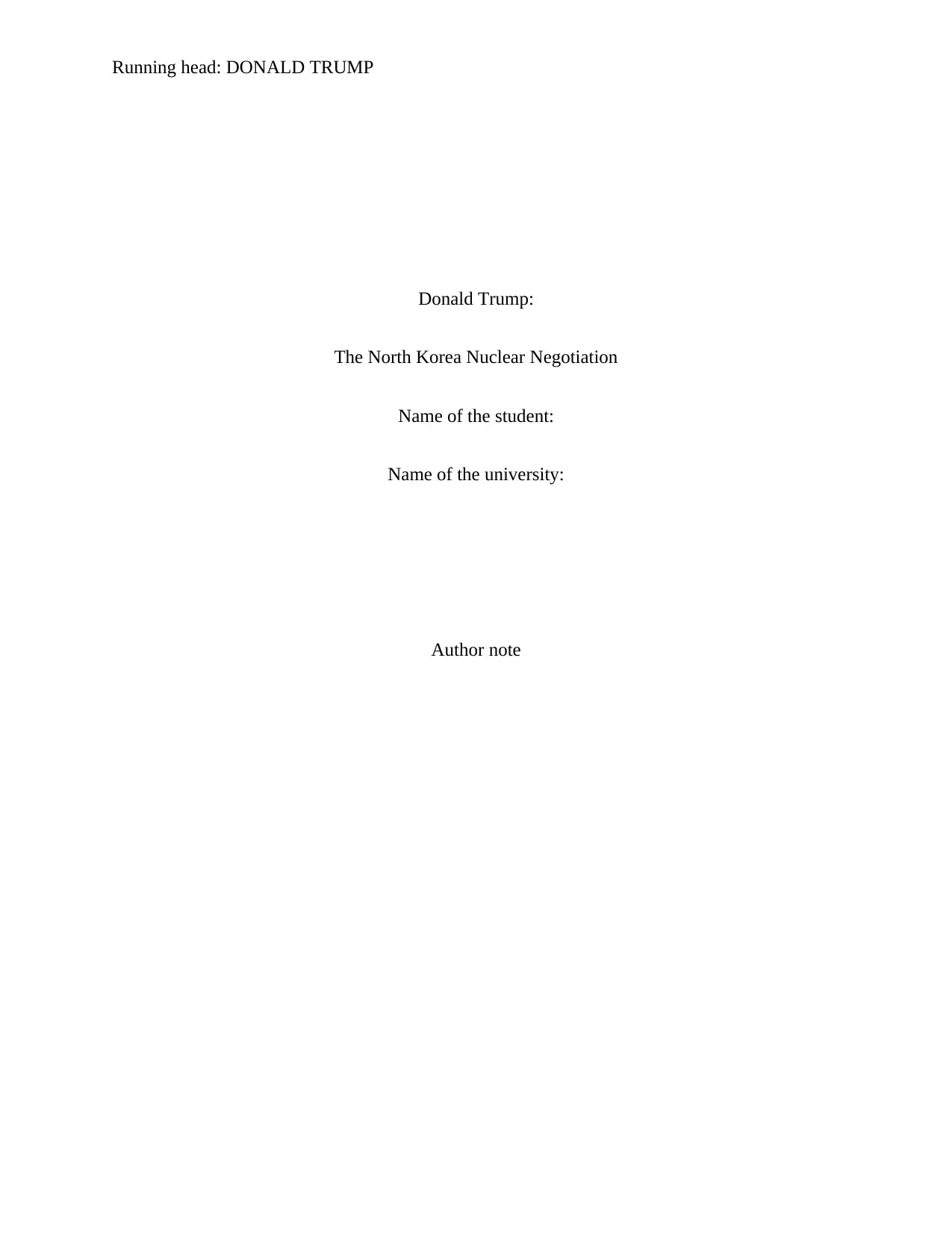
Running head: DONALD TRUMP
Donald Trump:
The North Korea Nuclear Negotiation
Name of the student:
Name of the university:
Author note
Donald Trump:
The North Korea Nuclear Negotiation
Name of the student:
Name of the university:
Author note
Paraphrase This Document
Need a fresh take? Get an instant paraphrase of this document with our AI Paraphraser
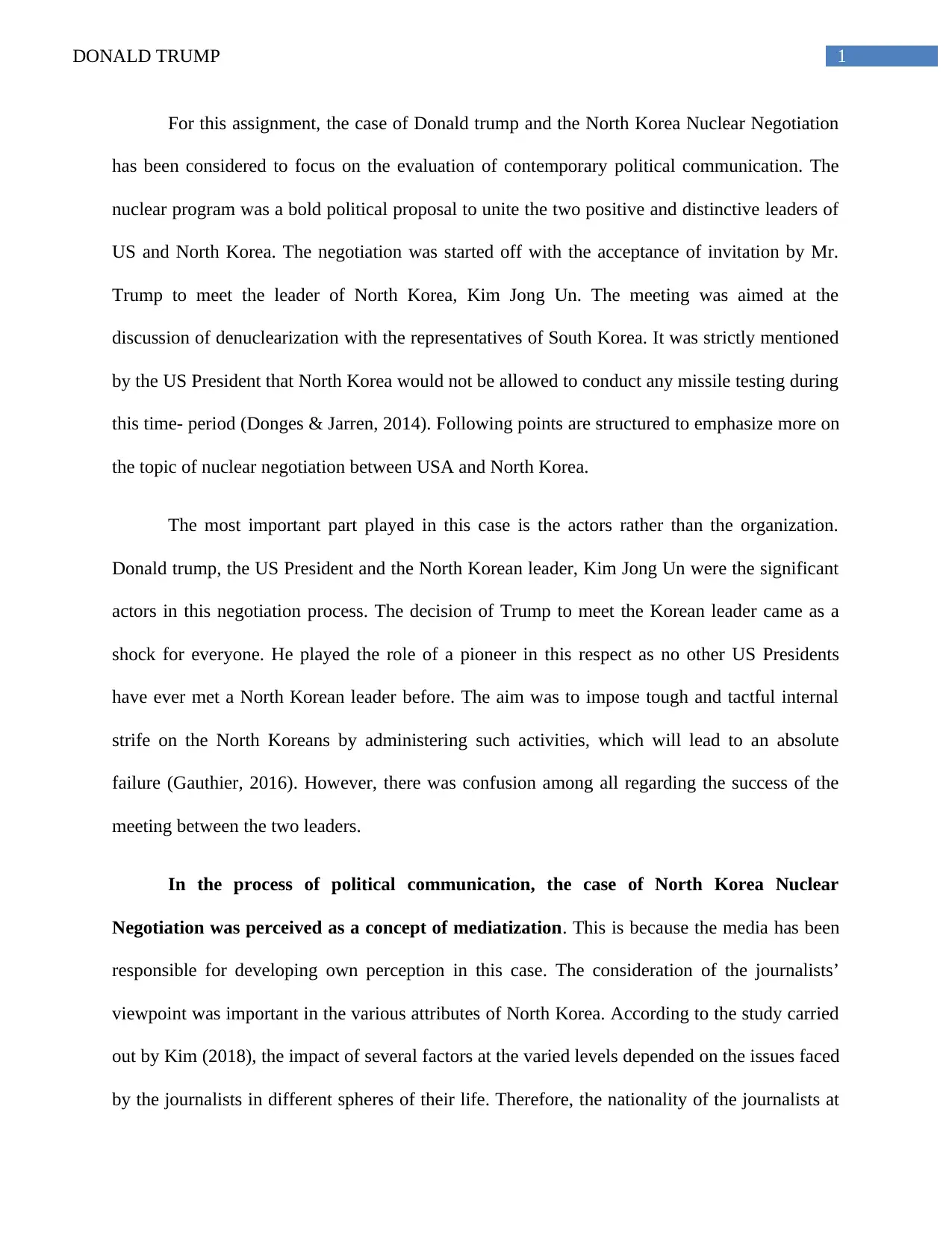
1DONALD TRUMP
For this assignment, the case of Donald trump and the North Korea Nuclear Negotiation
has been considered to focus on the evaluation of contemporary political communication. The
nuclear program was a bold political proposal to unite the two positive and distinctive leaders of
US and North Korea. The negotiation was started off with the acceptance of invitation by Mr.
Trump to meet the leader of North Korea, Kim Jong Un. The meeting was aimed at the
discussion of denuclearization with the representatives of South Korea. It was strictly mentioned
by the US President that North Korea would not be allowed to conduct any missile testing during
this time- period (Donges & Jarren, 2014). Following points are structured to emphasize more on
the topic of nuclear negotiation between USA and North Korea.
The most important part played in this case is the actors rather than the organization.
Donald trump, the US President and the North Korean leader, Kim Jong Un were the significant
actors in this negotiation process. The decision of Trump to meet the Korean leader came as a
shock for everyone. He played the role of a pioneer in this respect as no other US Presidents
have ever met a North Korean leader before. The aim was to impose tough and tactful internal
strife on the North Koreans by administering such activities, which will lead to an absolute
failure (Gauthier, 2016). However, there was confusion among all regarding the success of the
meeting between the two leaders.
In the process of political communication, the case of North Korea Nuclear
Negotiation was perceived as a concept of mediatization. This is because the media has been
responsible for developing own perception in this case. The consideration of the journalists’
viewpoint was important in the various attributes of North Korea. According to the study carried
out by Kim (2018), the impact of several factors at the varied levels depended on the issues faced
by the journalists in different spheres of their life. Therefore, the nationality of the journalists at
For this assignment, the case of Donald trump and the North Korea Nuclear Negotiation
has been considered to focus on the evaluation of contemporary political communication. The
nuclear program was a bold political proposal to unite the two positive and distinctive leaders of
US and North Korea. The negotiation was started off with the acceptance of invitation by Mr.
Trump to meet the leader of North Korea, Kim Jong Un. The meeting was aimed at the
discussion of denuclearization with the representatives of South Korea. It was strictly mentioned
by the US President that North Korea would not be allowed to conduct any missile testing during
this time- period (Donges & Jarren, 2014). Following points are structured to emphasize more on
the topic of nuclear negotiation between USA and North Korea.
The most important part played in this case is the actors rather than the organization.
Donald trump, the US President and the North Korean leader, Kim Jong Un were the significant
actors in this negotiation process. The decision of Trump to meet the Korean leader came as a
shock for everyone. He played the role of a pioneer in this respect as no other US Presidents
have ever met a North Korean leader before. The aim was to impose tough and tactful internal
strife on the North Koreans by administering such activities, which will lead to an absolute
failure (Gauthier, 2016). However, there was confusion among all regarding the success of the
meeting between the two leaders.
In the process of political communication, the case of North Korea Nuclear
Negotiation was perceived as a concept of mediatization. This is because the media has been
responsible for developing own perception in this case. The consideration of the journalists’
viewpoint was important in the various attributes of North Korea. According to the study carried
out by Kim (2018), the impact of several factors at the varied levels depended on the issues faced
by the journalists in different spheres of their life. Therefore, the nationality of the journalists at
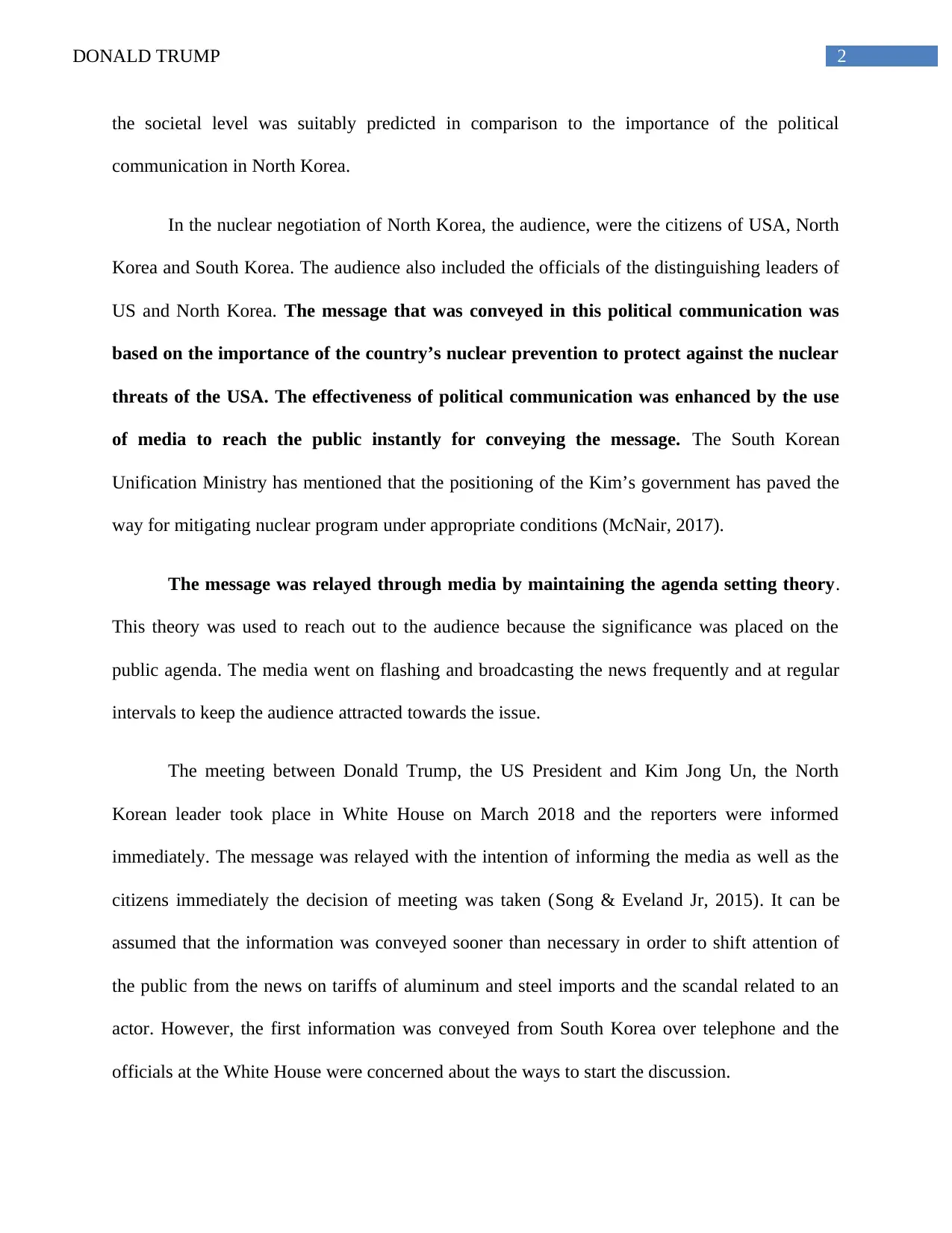
2DONALD TRUMP
the societal level was suitably predicted in comparison to the importance of the political
communication in North Korea.
In the nuclear negotiation of North Korea, the audience, were the citizens of USA, North
Korea and South Korea. The audience also included the officials of the distinguishing leaders of
US and North Korea. The message that was conveyed in this political communication was
based on the importance of the country’s nuclear prevention to protect against the nuclear
threats of the USA. The effectiveness of political communication was enhanced by the use
of media to reach the public instantly for conveying the message. The South Korean
Unification Ministry has mentioned that the positioning of the Kim’s government has paved the
way for mitigating nuclear program under appropriate conditions (McNair, 2017).
The message was relayed through media by maintaining the agenda setting theory.
This theory was used to reach out to the audience because the significance was placed on the
public agenda. The media went on flashing and broadcasting the news frequently and at regular
intervals to keep the audience attracted towards the issue.
The meeting between Donald Trump, the US President and Kim Jong Un, the North
Korean leader took place in White House on March 2018 and the reporters were informed
immediately. The message was relayed with the intention of informing the media as well as the
citizens immediately the decision of meeting was taken (Song & Eveland Jr, 2015). It can be
assumed that the information was conveyed sooner than necessary in order to shift attention of
the public from the news on tariffs of aluminum and steel imports and the scandal related to an
actor. However, the first information was conveyed from South Korea over telephone and the
officials at the White House were concerned about the ways to start the discussion.
the societal level was suitably predicted in comparison to the importance of the political
communication in North Korea.
In the nuclear negotiation of North Korea, the audience, were the citizens of USA, North
Korea and South Korea. The audience also included the officials of the distinguishing leaders of
US and North Korea. The message that was conveyed in this political communication was
based on the importance of the country’s nuclear prevention to protect against the nuclear
threats of the USA. The effectiveness of political communication was enhanced by the use
of media to reach the public instantly for conveying the message. The South Korean
Unification Ministry has mentioned that the positioning of the Kim’s government has paved the
way for mitigating nuclear program under appropriate conditions (McNair, 2017).
The message was relayed through media by maintaining the agenda setting theory.
This theory was used to reach out to the audience because the significance was placed on the
public agenda. The media went on flashing and broadcasting the news frequently and at regular
intervals to keep the audience attracted towards the issue.
The meeting between Donald Trump, the US President and Kim Jong Un, the North
Korean leader took place in White House on March 2018 and the reporters were informed
immediately. The message was relayed with the intention of informing the media as well as the
citizens immediately the decision of meeting was taken (Song & Eveland Jr, 2015). It can be
assumed that the information was conveyed sooner than necessary in order to shift attention of
the public from the news on tariffs of aluminum and steel imports and the scandal related to an
actor. However, the first information was conveyed from South Korea over telephone and the
officials at the White House were concerned about the ways to start the discussion.
⊘ This is a preview!⊘
Do you want full access?
Subscribe today to unlock all pages.

Trusted by 1+ million students worldwide
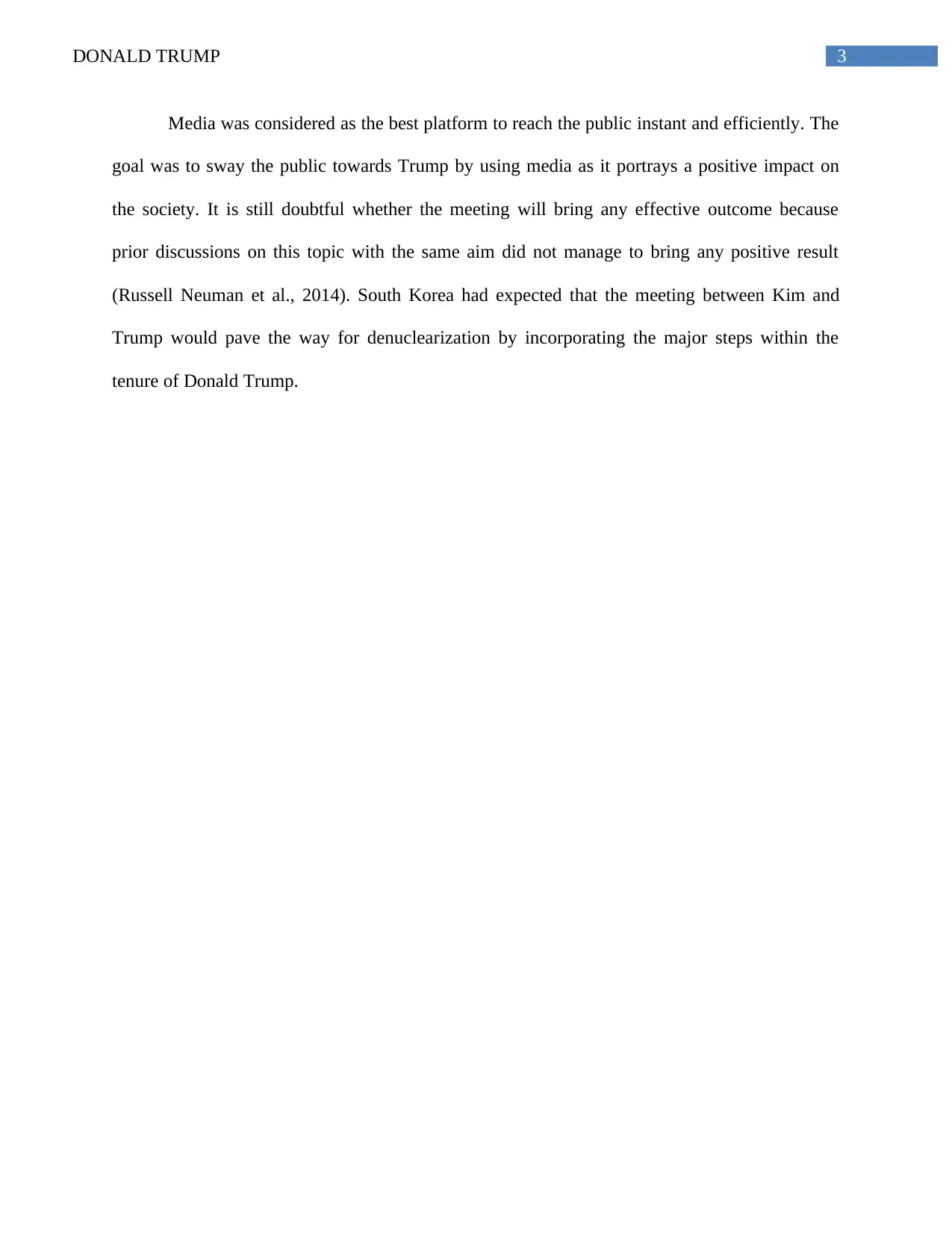
3DONALD TRUMP
Media was considered as the best platform to reach the public instant and efficiently. The
goal was to sway the public towards Trump by using media as it portrays a positive impact on
the society. It is still doubtful whether the meeting will bring any effective outcome because
prior discussions on this topic with the same aim did not manage to bring any positive result
(Russell Neuman et al., 2014). South Korea had expected that the meeting between Kim and
Trump would pave the way for denuclearization by incorporating the major steps within the
tenure of Donald Trump.
Media was considered as the best platform to reach the public instant and efficiently. The
goal was to sway the public towards Trump by using media as it portrays a positive impact on
the society. It is still doubtful whether the meeting will bring any effective outcome because
prior discussions on this topic with the same aim did not manage to bring any positive result
(Russell Neuman et al., 2014). South Korea had expected that the meeting between Kim and
Trump would pave the way for denuclearization by incorporating the major steps within the
tenure of Donald Trump.
Paraphrase This Document
Need a fresh take? Get an instant paraphrase of this document with our AI Paraphraser
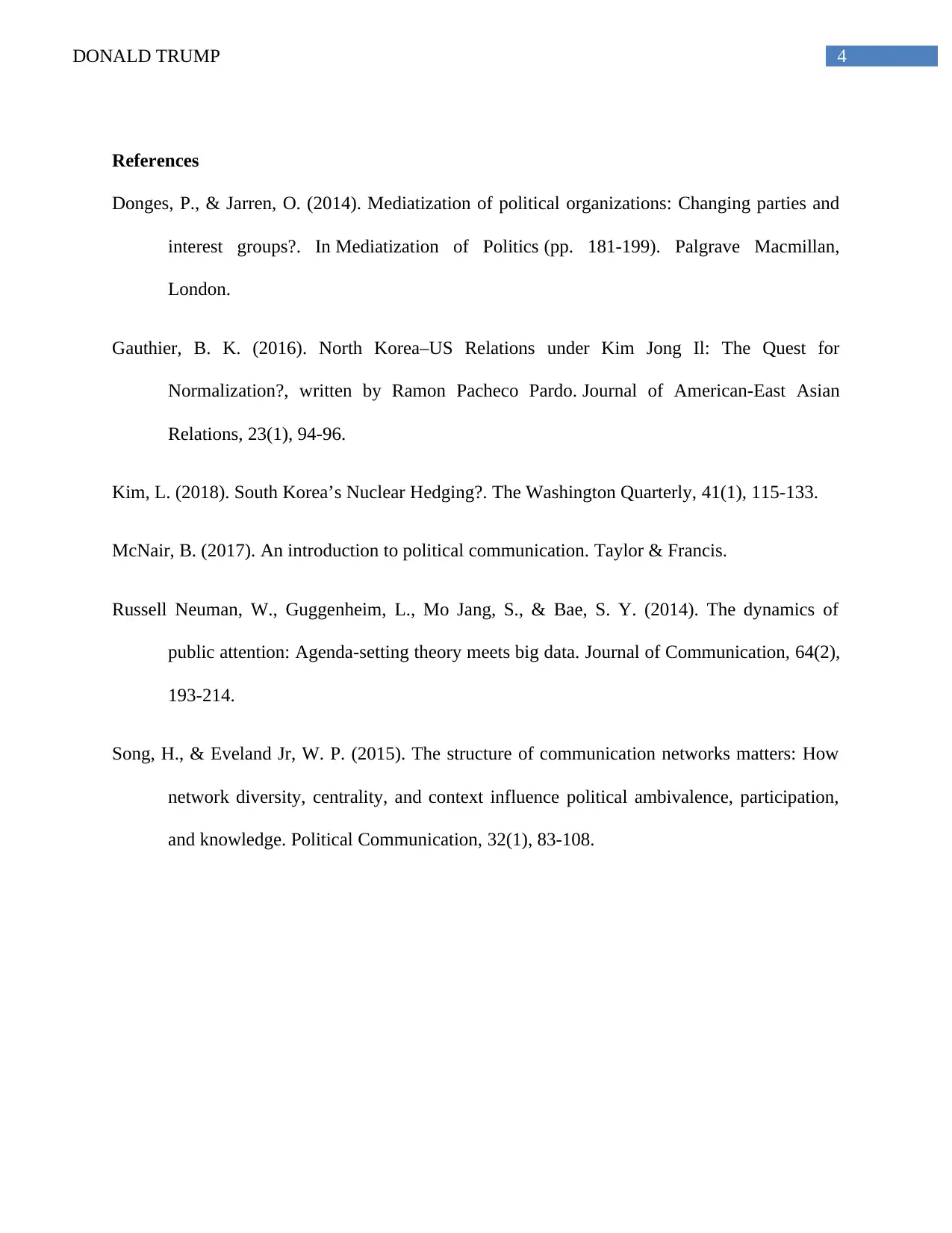
4DONALD TRUMP
References
Donges, P., & Jarren, O. (2014). Mediatization of political organizations: Changing parties and
interest groups?. In Mediatization of Politics (pp. 181-199). Palgrave Macmillan,
London.
Gauthier, B. K. (2016). North Korea–US Relations under Kim Jong Il: The Quest for
Normalization?, written by Ramon Pacheco Pardo. Journal of American-East Asian
Relations, 23(1), 94-96.
Kim, L. (2018). South Korea’s Nuclear Hedging?. The Washington Quarterly, 41(1), 115-133.
McNair, B. (2017). An introduction to political communication. Taylor & Francis.
Russell Neuman, W., Guggenheim, L., Mo Jang, S., & Bae, S. Y. (2014). The dynamics of
public attention: Agenda-setting theory meets big data. Journal of Communication, 64(2),
193-214.
Song, H., & Eveland Jr, W. P. (2015). The structure of communication networks matters: How
network diversity, centrality, and context influence political ambivalence, participation,
and knowledge. Political Communication, 32(1), 83-108.
References
Donges, P., & Jarren, O. (2014). Mediatization of political organizations: Changing parties and
interest groups?. In Mediatization of Politics (pp. 181-199). Palgrave Macmillan,
London.
Gauthier, B. K. (2016). North Korea–US Relations under Kim Jong Il: The Quest for
Normalization?, written by Ramon Pacheco Pardo. Journal of American-East Asian
Relations, 23(1), 94-96.
Kim, L. (2018). South Korea’s Nuclear Hedging?. The Washington Quarterly, 41(1), 115-133.
McNair, B. (2017). An introduction to political communication. Taylor & Francis.
Russell Neuman, W., Guggenheim, L., Mo Jang, S., & Bae, S. Y. (2014). The dynamics of
public attention: Agenda-setting theory meets big data. Journal of Communication, 64(2),
193-214.
Song, H., & Eveland Jr, W. P. (2015). The structure of communication networks matters: How
network diversity, centrality, and context influence political ambivalence, participation,
and knowledge. Political Communication, 32(1), 83-108.
1 out of 5
Related Documents
Your All-in-One AI-Powered Toolkit for Academic Success.
+13062052269
info@desklib.com
Available 24*7 on WhatsApp / Email
![[object Object]](/_next/static/media/star-bottom.7253800d.svg)
Unlock your academic potential
Copyright © 2020–2025 A2Z Services. All Rights Reserved. Developed and managed by ZUCOL.





